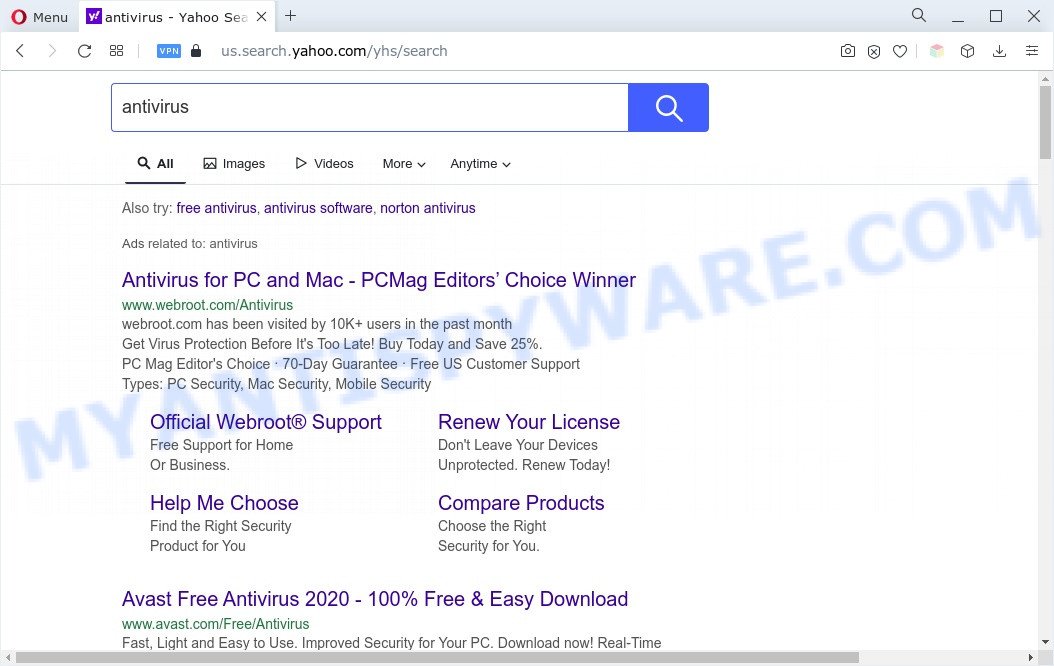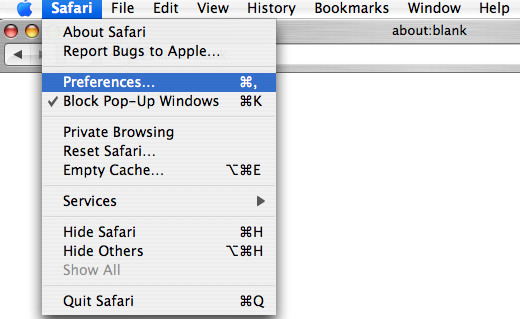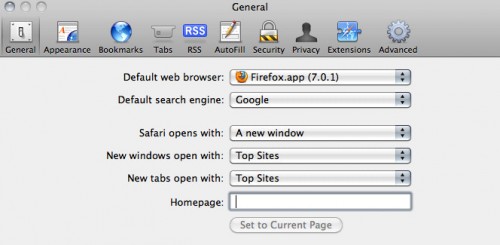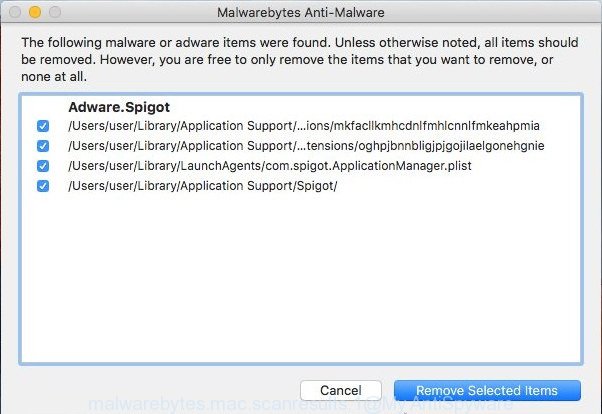If your browser suddenly starts showing the Search.navigationbuffer.com when you did not set it as your homepage or search provider, then most probably that you’ve a potentially unwanted application (PUA) from the Browser hijackers family installed on the MAC OS. A common tactic used by potentially unwanted software developers is to change web-browser’s settings like home page, new tab and search provider by default so that the affected web-browser goes to a web-page under the author’s control. In order to scan for PUPs, remove Search.navigationbuffer.com from your browser, you can follow the useful guidance below.

Search.navigationbuffer.com redirect user searches to yahoo
When you are performing searches using the web browser that has been affected by Search.navigationbuffer.com, the search results will be returned from Bing, Yahoo or Google Custom Search. The devs behind Search.navigationbuffer.com hijacker are most probably doing this to make advertisement revenue from the ads shown in the search results.
Another reason why you need to get rid of Search.navigationbuffer.com is its online data-tracking activity. It can collect confidential information, including:
- IP addresses;
- URLs visited;
- search queries/terms;
- clicks on links and ads;
- internet browser version information.
How can Search.navigationbuffer.com get on your MAC OS
The browser hijacker most likely to occur during the install of freeware due the fact that potentially unwanted applications like this are usually hidden in the setup file. Thus, if you have installed some free applications using Quick(Standard) method, you may have let a hijacker get inside the Apple Mac. Keep in mind that the Quick mode is unreliable because it do not warn about additional programs. Thus, third-party apps will be installed automatically unless you select Advanced/Custom method and reject its installation.
Threat Summary
| Name | Search.navigationbuffer.com |
| Type | redirect virus, home page hijacker, PUP, browser hijacker, search provider hijacker |
| Affected Browser Settings | newtab page URL, start page, search engine |
| Symptoms |
|
| Removal | Search.navigationbuffer.com removal guide |
How to Remove Search.navigationbuffer.com from Mac
There are several steps to deleting Search.navigationbuffer.com redirect, because it installs itself so deeply into Apple Mac. You need to remove all suspicious and unknown software, then delete harmful add-ons from the Firefox, Google Chrome and Safari and other web-browsers you’ve installed. Finally, you need to reset your internet browser settings to get rid of any changes Search.navigationbuffer.com hijacker infection has made, and then check your computer with MalwareBytes AntiMalware (MBAM) to ensure the browser hijacker is fully removed. It will take a while.
To remove Search.navigationbuffer.com, use the following steps:
- How to remove Search.navigationbuffer.com without any software
- Automatic Removal of Search.navigationbuffer.com/a>
- Stop Search.navigationbuffer.com redirect
- To sum up
How to remove Search.navigationbuffer.com without any software
The following instructions is a step-by-step guide, which will help you manually remove Search.navigationbuffer.com redirect from the Firefox, Chrome and Safari.
Uninstall PUPs through the Finder
In order to remove Search.navigationbuffer.com, first thing you need to do is to remove unknown and questionable applications from your MAC system using the Finder. When removing this hijacker, check the list of installed apps and try to find dubious applications and delete them all. Pay special attention to recently installed apps, as it’s most probably that the Search.navigationbuffer.com hijacker сame along with it.
Open Finder and click “Applications”.

Carefully browse through the list of installed software and remove all dubious and unknown programs.
When you have found anything dubious that may be the browser hijacker which cause a redirect to the Search.navigationbuffer.com webpage or other PUP, then right click this program and select “Move to Trash”. Once complete, Empty Trash.
Remove Search.navigationbuffer.com home page from Safari
By resetting Safari browser you revert back your browser settings to its default state. This is good initial when troubleshooting problems that might have been caused by browser hijacker like Search.navigationbuffer.com.
Click Safari menu and select “Preferences”.

It will open the Safari Preferences window. Next, click the “Extensions” tab. Look for unknown and suspicious plugins on left panel, select it, then press the “Uninstall” button. Most important to delete all unknown plugins from Safari.
Once complete, click “General” tab. Change the “Default Search Engine” to Google.

Find the “Homepage” and type into textfield “https://www.google.com”.
Remove Search.navigationbuffer.com from Google Chrome
The Search.navigationbuffer.com website as your search engine or start page or other symptom of having browser hijacker infection in your web-browser is a good reason to reset Chrome. This is an easy way to restore the Chrome settings and not lose any important information.
First run the Chrome. Next, click the button in the form of three horizontal dots (![]() ).
).
It will show the Chrome menu. Choose More Tools, then click Extensions. Carefully browse through the list of installed extensions. If the list has the extension signed with “Installed by enterprise policy” or “Installed by your administrator”, then complete the following tutorial: Remove Google Chrome extensions installed by enterprise policy.
Open the Chrome menu once again. Further, click the option named “Settings”.

The internet browser will display the settings screen. Another solution to open the Chrome’s settings – type chrome://settings in the web browser adress bar and press Enter
Scroll down to the bottom of the page and click the “Advanced” link. Now scroll down until the “Reset” section is visible, as shown on the screen below and press the “Reset settings to their original defaults” button.

The Chrome will show the confirmation prompt as displayed in the following example.

You need to confirm your action, click the “Reset” button. The internet browser will launch the task of cleaning. After it is complete, the web browser’s settings including new tab, default search engine and startpage back to the values which have been when the Chrome was first installed on your Apple Mac.
Get rid of Search.navigationbuffer.com from Firefox by resetting web-browser settings
Resetting Firefox web browser will reset all the settings to their original state and will remove Search.navigationbuffer.com redirect, malicious add-ons and extensions. Essential information such as bookmarks, browsing history, passwords, cookies, auto-fill data and personal dictionaries will not be removed.
Press the Menu button (looks like three horizontal lines), and press the blue Help icon located at the bottom of the drop down menu as displayed on the image below.

A small menu will appear, click the “Troubleshooting Information”. On this page, click “Refresh Firefox” button like below.

Follow the onscreen procedure to restore your Firefox browser settings to their default state.
Automatic Removal of Search.navigationbuffer.com
If your Apple Mac is still infected with the Search.navigationbuffer.com redirect, then the best method of detection and removal is to use an anti-malware scan on the computer. Download free malicious software removal tools below and run a full system scan. It will help you remove all components of the hijacker infection from hardisk and system folders.
How to remove Search.navigationbuffer.com with MalwareBytes
Remove Search.navigationbuffer.com browser hijacker manually is difficult and often the browser hijacker infection is not completely removed. Therefore, we recommend you to run the MalwareBytes Free which are fully clean your MAC system. Moreover, this free program will help you to remove malware, potentially unwanted programs, toolbars and adware that your MAC system may be infected too.
Please go to the link below to download MalwareBytes.
20945 downloads
Author: Malwarebytes
Category: Security tools
Update: September 10, 2020
Once the download is done, close all windows on your machine. Further, open the saved file. Follow the prompts.
The MalwareBytes Anti Malware will automatically start and you can see its main window as on the image below.
Next, press the “Scan Now” button to scan for browser hijacker which redirects your browser to the Search.navigationbuffer.com web-site. A scan can take anywhere from 10 to 30 minutes, depending on the number of files on your MAC system and the speed of your Apple Mac. During the scan MalwareBytes will scan for threats present on your machine.

Once MalwareBytes Anti Malware has finished scanning your MAC OS, it will open the Scan Results. Review the results once the utility has done the system scan. If you think an entry should not be quarantined, then uncheck it. Otherwise, simply click “Remove Selected Items” button.

The MalwareBytes Anti Malware will begin to delete browser hijacker that causes web-browsers to open the Search.navigationbuffer.com webpage.
Stop Search.navigationbuffer.com redirect
In order to increase your security and protect your MAC system against new intrusive advertisements and malicious web sites, you need to run ad blocking application that blocks an access to harmful advertisements and web-sites. Moreover, the application can stop the display of intrusive advertising, that also leads to faster loading of web pages and reduce the consumption of web traffic.

- Download AdGuard by clicking on the link below.
AdGuard for Mac download
3753 downloads
Author: © Adguard
Category: Security tools
Update: January 17, 2018
- Once the download is complete, run the downloaded file. You will see the “Setup Wizard” program window. Follow the prompts.
- When the installation is complete, click “Skip” to close the installation program and use the default settings, or click “Get Started” to see an quick tutorial that will assist you get to know AdGuard better.
- In most cases, the default settings are enough and you don’t need to change anything. Each time, when you launch your Apple Mac, AdGuard will launch automatically and stop undesired advertisements, block Search.navigationbuffer.com, as well as other harmful or misleading web-sites.
To sum up
Once you have finished the guidance above, your machine should be free from browser hijackers and other malicious software. The Google Chrome, Safari and Mozilla Firefox will no longer display the Search.navigationbuffer.com webpage on startup. Unfortunately, if the few simple steps does not help you, then you have caught a new hijacker, and then the best way – ask for help here.

















